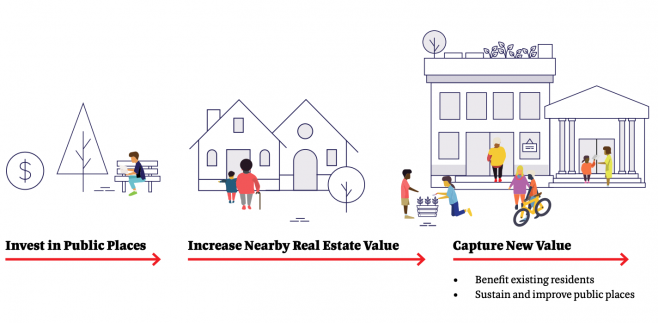Harnessing the value of public assets to support the civic commons
It’s widely recognized that public assets, like parks, libraries and community centers, generate important and tangible benefits for their neighborhoods. But it’s seldom the case that the value of these benefits is tapped to help generate revenue to enhance and maintain the public assets. A new toolkit developed by U3 for Reinvigorating the Civic Commons outlines programs and tactics that neighborhoods and cities can use to capture value from public assets.
Value capture strategies are based on the observation that well functioning public facilities often contribute to local economic growth, business revenues and property appreciation. Much or all of the economic value from these facilities often spills over to or benefits neighbors or adjacent properties, but doesn’t directly provide additional revenue to finance or maintain the facilities themselves. Value capture mechanisms aim to close this loop by capturing a portion of the value created by a public investment and using it to help support the asset itself.
Value capture can play an important role, especially in rapidly changing neighborhoods. Public resources, like parks, often play a key role in stimulating additional investment and drawing new residents, with the perception that there’s little benefit for existing residents of the neighborhood. Value capture mechanisms, like tax increment financing, can create a pool of resources for maintaining or improving the public realm, or as some cities have done, subsidizing the construction of affordable housing that keeps the neighborhood accessible for households from a range of different incomes.
The toolkit sketches out a range of different value capture mechanisms, some of which have been employed widely around the country, and others, like land value taxation, that are relatively rare. The report discusses at what scale (project, neighborhood or city) each mechanism is most appropriate, as well as their merits and drawbacks.
U3’s value capture toolkit was developed collaboratively by practitioners and philanthropic, economic and civic asset experts. (Full disclosure: City Observatory’s Joe Cortright participated in this group). A beta version was of the value capture toolkit was reviewed at a Civic Commons Studio in Philadelphia earlier this year.



